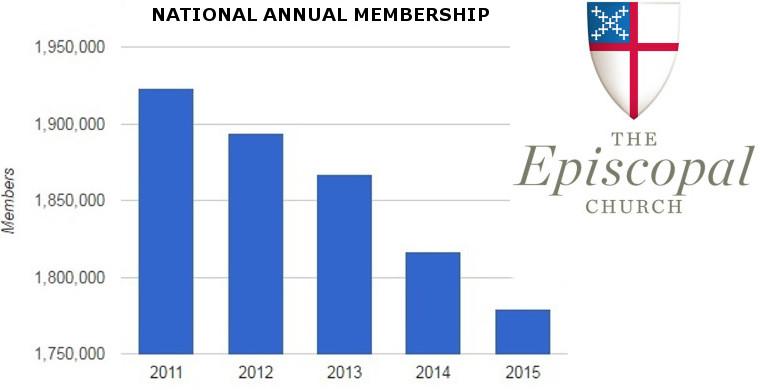The Decline of the Episcopal Church
By David W. Virtue, DD
www.virtueonline.org
July 24, 2017
The Episcopal Church lost almost a quarter of its members from 1986 to 2010, within the context of a rapidly rising population. Between 2010 and 2015, TEC's baptized membership dropped further by 172,000 to 1,779,335, meaning the overall drop in membership from 1980 to 2015 was on the order of 30%.
This and other findings were made by Dr. Jeremy Bonner, a Durham-based researcher and reported by David Goodhew for Covenant, the weblog of The Living Church in a no holds barred look at the decline of The Episcopal Church.
During the 1990s, average Sunday attendance was relatively stable, but from around 2000, serious decline set in. This has continued and TEC's average Sunday attendance dropped by nearly one third between 2000 and 2015, from 857,000 in 2000 to 579,780 by 2015. While there is some regional variation, substantial decline has been happening across the country.
The rate of baptism has been cut almost in half over a thirty-year period. But the rate of decline has steepened. Child baptisms increased slightly in the early 1980s, then declined dramatically from around 1990. That decline has continued since 2010. In 2000, TEC baptized 46,603 children, but new numbers show that in 2015, TEC baptized 24,069 children, nearly half the number baptized in 2000.
Adult baptism's decline was even more striking. In 2015, 3,305 adults were baptized by TEC, less than half the number of adults TEC baptized in 2000: 7,231.
However startling the drop in baptisms, the most dramatic data was for marriages. Here the decline was shown to be steady, from 38,913 in 1980 to 11,613 in 2010. This dropped further to 9149 in 2015. In other words, in 2015 TEC married less than a quarter of the number it married in 1980!
Comparison with other churches and other denominations was equally revealing. Are things worse for TEC than elsewhere, or sometimes better? Bonner's research showed that between 1980 and 2010, some American denominations grew (notably Roman Catholicism, the Southern Baptist Convention, Mormons and Pentecostals -- although some of these have seen their rate of growth shrink in recent years) and others have declined to varying degrees. TEC is not the worst performing of U.S. denominations, but it is one of the worst. The mainline churches have, in the main, done worse than the non-mainline.
From the early 1990s TEC has started around 12 congregations a year across the United States, markedly fewer than in the 1970s and '80s and vastly fewer than in the 1950s and '60s (when between 40 and 100 were being founded each year). Wider evidence suggests that disinterest in starting new congregations correlates with a greater propensity to decline.
Division? One explanation is division. TEC lost a number of congregations in recent years to what is now the Anglican Church in North America (ACNA). But TEC has declined by a far larger amount than can be accounted for by such divisions. Moreover, in several key metrics, TEC's decline long predates these divisions. Even if you add TEC and ACNA together, Anglicanism in the United States has dramatically declined in recent years, notes Bonner.
What are the lessons for the wider Church? U.S. Anglicanism operates in a very different context to other parts of Anglicanism. That said, there is much for wider Anglicanism to learn from the U.S. experience. Bonner's analysis shows how TEC has dramatically declined in recent years. There is a sense that the wider Anglican Communion has not awakened to how far and fast that decline has happened.
VOL. Not true. The Global South, especially GAFCON, have been made painfully aware of TEC's losses from several sources including VOL over the years..
In significant parts of the United States, TEC has ceased or will soon cease to have a meaningful presence. That said, those who write TEC off are overstating their case. Despite severe decline, it remains a substantial presence in parts of the nation, especially in some major cities.
The article examined data from the Episcopal Church's dioceses in the United States. It did not include overseas dioceses, such as those in Province IX, where the situation is quite different.
The Rev. Dr. David Goodhew is director of ministerial practice at Cranmer Hall, St. John's College, Durham University, England. The full article which can be seen here:
http://livingchurch.org/covenant/wp-content/uploads/2017/07/Goodhew-Facing-Episcopal-Church-decline.pdf
END














